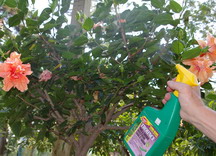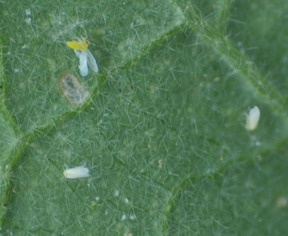|
Hibiscus As Container Plants
|

Let’s Take Them Indoors!
Moving such plants indoors can be problematic. Unless we can move them beside very large south or west facing windows they are unlikely to continue blooming. When the last of the summer flowers fade, the plant can continue to survive in a reduced light situation. Then by midwinter, we find some bugs also seem to thrive. Where were those *%&$#* bugs all summer.
Uninvited Bugs!
Well, those bugs were doing quite nicely, unnoticed, on your plants. When the plant is growing well, it stays ahead of the bugs and a variety of natural predators also helps. We bring the plants inside to the stresses of a low light, low humidity life style. We don’t invite the predators in because they make lousy house guests. Suddenly an insignificant population of bugs is given the ideal circumstances to flourish and flourish they do. Plants survive indoors; bugs flourish. It’s not fair but who told you life would be fair. Knowing the potential problem is one thing. Knowing what to do about it is another. When your plants are still outside in the fall, take some preventative action. It will make winter life indoors a bit easier.
 Control Bugs Before Moving Plants
Control Bugs Before Moving Plants
On my Hibiscus, I have two main pests. Spider mites and Whiteflies both have an affinity for Hibiscus and for many other plants that we migrate with the seasons. Spraying is the answer and it’s easier outside. Less mess. Less smell. Less collateral damage. These pests are relatively easy to kill as adults. I use a product called Trounce, although there are several others. It is a mixture of insecticidal soap and pyrethrum, an organic insecticide. The secret to success is realizing what it does or more importantly what it does not do. It is a contact insecticide. It must directly contact these bugs as you apply it. There is no residual action and tomorrow’s egg hatch will be unaffected. These pests both have very short life cycles of 4 – 5 days. Spray on Monday – spray again next Monday and you have missed a generation. Before my Hibiscus comes in, I spray it, every other day, at least 3-4 times. Again the trick is to contact the bugs and they live mostly on the underside of the leaves so get up and under with that spray for the greatest effect. Whitefly, fly less in the dark, so try spraying in the evening when they are sitting still on the leaves. That seems to solve most of the problem.

The Winter Reappearance!
Somehow, from somewhere, in late winter, the white fly,(picture right,) seem to magically reappear. So do the spider mites but on Hibiscus the Whitefly are much more obvious. I have a simple solution. I don’t like spraying, even the mild organic sprays, indoors. It’s messy. By March when the bugs may be starting to bug you; the plant is straggly, dropping leaves and generally unattractive. You don’t want it to get so large next summer that bringing it in next fall requires a bigger house. Pruning is the simple solution to both problems.
Pruning: When and How?
My pruning technique for Hibiscus could be described as vicious.
In The Spring!
By the time the weather is warm enough for our Hibiscus to move outside it will have started to grow quite nicely. The gorgeous blooms, the reason for all of this effort, develop at the end of the new growth. The wintering and pruning program has produced an abundance of that growth and your deck should be filled with blooms all summer on a plant that is compact and well shaped.
return from Hibiscus to Houseplants main page
Get answers to your gardening questions by subscribing to
Ken’s free newsletter, Dallying In The Dirt
